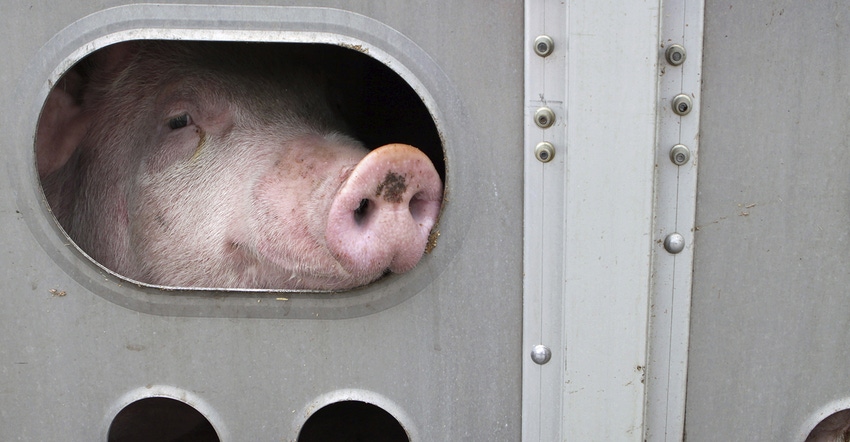Hog slaughter still below pre-COVID levels
Outlook is brighter for 2021, as futures prices imply that it will be a profitable year, with solid profits in the second and third quarters.

Hog prices are dismal. Through late-August the average carcass price for producer-sold hogs was $57.43 per hundredweight, down $13.23 from the year before. Negotiated barrow and gilt carcass prices were far lower, averaging only $41.77 per hundredweight, down $24.06 from last year.
The huge gap between negotiated prices and the average price for all producer sales shows the importance of having a marketing contract, especially one that includes cutout value or futures market prices in the formula.

Currently, the lean hog futures price average for September 2020 thru August 2021 is $64 per hundredweight. The futures market implies carcass hog prices will average $13 per hundredweight higher in 2021 than this year.
There are two main causes of this year's low hog prices. One is a huge supply of market hogs. Hog slaughter in 2020 is expected to be record high for the sixth consecutive year. The other cause for low hog prices is that COVID-19 has forced packers to scale back their slaughter schedules to protect their employees.
During March, daily hog slaughter exceeded 490,000 head 18 times and exceeded 500,000 four times. The smallest weekday slaughter during March was 487,172 head. During April and May weekday hog slaughter was under 400,000 head on 23 days and under 300,000 on five days.

Hog slaughter is up 2.0% thus far in 2020. That is 5.2% less than indicated by the June pig report.
Will packers be able to handle the hog run coming this fall? It looks iffy. Since March, the biggest daily slaughter is 487,640 hogs. During the last third of 2019, daily hog slaughter exceeded 490,000 head 35 times.
Hog slaughter is usually low during the summer due to a shortage of hogs. That should not have been a problem this summer. If the June hog inventory was correct, over 2 million hogs were backed up on farms during April and May.
Packers had incentive to process all the hogs they could. Through mid-August, 2020 packer gross margins on producer-sold hogs averaged $42.16 per head, up 68.6% compared to $25 per head during the same period last year. Granted, packer operating costs were higher due to extra costs caused by COVID-19.

The next hogs and pigs inventory survey will be released on Sept. 24.
Given record hog slaughter, lower hog prices were expected, but that hasn't translated into lower retail pork prices. In the first seven months of 2020, retail pork prices have averaged 4.3% higher than in 2019. Grocery store pork prices have been above the year-ago level each month of 2020 and were record high in June. Lower hog prices and higher retail prices mean that the farm-to-retail margin has been way up this year. The farm-to-retail price spread averaged $3.301 per hundredweight during the first seven months of 2020. That was 11.4% higher than the same period last year.
International pork trade has had a big impact on the 2020 pork market. During the first half of 2020, U.S. pork production was up 2.1% and exports were up 27.4%. The first six months saw 27.5% of U.S. pork production exported. The big increase in exports was due to a whopping 355.6% increase in shipments to China. Chinese pork production is down because of African swine fever. During the first half of 2020, 32.5% of U.S. pork exports went to China, 19.2% to Mexico, 15.9% to Japan, 7.6% to South Korea, 7.1% to Canada and 17.7% to everybody else. U.S. pork exports to nations other than China were down 5.4%.

Through June, U.S. pork imports were down 12.3%. Imports from Canada were up 5.8%, but imports from the rest of the world were down 35.2%. January-June imports equaled 3.1% of U.S. pork production.
USDA World Agricultural Supply and Demand Estimates is forecasting much slower growth in pork exports during the second half of the year. For all of 2020, they think pork exports will be up 19.4%.
According to calculations by Lee Schulz at Iowa State University, the cost of production for May-July averaged between $60 and $61 per hundredweight of hog carcass. Cost of production is expected to decline slightly in the fourth quarter, then very slowly increase as we move through next year, with 2021 costs up 2% from this year.
Schulz's estimate of profits per hog marketed for May, June and July was, $10.95, -$23.30, -$21.55, respectively. May was the only month of the last nine with a profit. The futures market indicates that each remaining month in 2020 is likely to also have red ink, making 2020 the least profitable year since 2012.
However, the outlook is brighter for 2021. Futures prices imply that 2021 will be a profitable year, with modest red ink at the start and the end, but with solid profits in the second and third quarters. One of the reasons 2020 hog prices are so low is because of six consecutive years of record slaughter. One reason that hog inventory has kept growing for so long is because the futures market keeps indicating that "next year" will be profitable.

Sow slaughter thus far in 2020 is up 11.7% compared to the same weeks last year. Sow slaughter has been above the year-earlier level each week of 2020, despite year-to-date imports of Canadian sows and boars being down 3.1%.

The Canadian swine herd was up 0.2% at the start of July. Their market hog inventory was up 0.1% and their breeding herd was up 1.5%. In comparison, on June 1 the U.S. swine herd was up 4.4% with the breeding herd down 0.9% and the market herd up 4.9%.
Source: Ron Plain, who is solely responsible for the information provided, and wholly owns the information. Informa Business Media and all its subsidiaries are not responsible for any of the content contained in this information asset. The opinions of this writer are not necessarily those of Farm Progress/Informa.
About the Author(s)
You May Also Like





